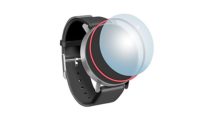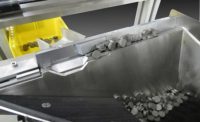Five Things: Adhesives and Dispensing








Bio-Based Hot-Melt Adhesive for Consumer Electronics Assembly
The one-part, moisture-cure adhesive can be used for a range of bonding applications for mobile phones, laptops, tablets, wearables and accessories. It is compatible with a variety of substrates, including plastics, metals and glass. It can be used in high-volume production, and it can be applied in narrow bond lines via jetting or needle dispensing. The adhesive is also fluorescent to facilitate in-line automatic optical inspection
Henkel has introduced Loctite HHD 3544F, the first bio-based polyurethane reactive (PUR) hot-melt adhesive for consumer electronics assembly. Approximately two-thirds of the adhesive’s content is sourced from renewable, plant-based feedstocks.
“Loctite HHD 3544F is an important advancement for the electronics industry,” explains David Peard, Henkel market segment manager and sustainability ambassador for consumer electronics. “Replacing conventional fossil fuel-based raw materials with renewable substitutes is a challenging endeavor. Nearly two years in development, Loctite HHD 3544F is a notable structural adhesive innovation and the first product in an expanding Henkel portfolio of bio and renewable material solutions for the consumer electronics sector.”
The one-part, moisture-cure adhesive can be used for a range of bonding applications for mobile phones, laptops, tablets, wearables and accessories. It is compatible with a variety of substrates, including plastics, metals and glass. It can be used in high-volume production, and it can be applied in narrow bond lines via jetting or needle dispensing. The adhesive is also fluorescent to facilitate in-line automatic optical inspection.
Vision System Inspects Width, Location of Primer on Automotive Glass
Coherix Inc. has introduced PrimerMaster Pro, a 3D vision system that inspects the width and location of primer and isopropyl alcohol applied on windshields, rear windows and other automotive glass.
Proper application of primer and alcohol is critical to the automotive glazing process to ensure that urethane adhesive sticks to the glass. Primer and alcohol evaporate rapidly, so detecting the presence or absence of these materials has been an issue for the automotive and glass manufacturing industries for years.
Embedded with proprietary software, the vision system provides real-time information on the width and location of primer and alcohol, and it detects skips. An external computer is not needed. The system is unaffected by changes in ambient lighting.
PrimerMaster Pro can also tell engineers precisely when to change dispensing tips. This helps to reduce operating expenses by enabling engineers to get the most use out of dispensing components.
Nordson EFD Expands Line of Optimum Syringe Barrels
The larger barrel features the same ZeroDraft walls as other Optimum syringe barrels. Its consistent internal diameter maintains the proper seal with the piston for consistent dispensing results.
All syringe barrels are manufactured in Nordson EFD’s silicone-free facilities in the United States and certified for industrial use.
Nordson EFD has added a 70-cc syringe barrel to its Optimum line of dispensing components. It’s the largest size in the line, which also includes 3-, 5-, 10-, 30- and 55-cc barrels.
“We saw a need in the market for the larger sized barrel,” says Felicitas Stuebing, product line manager for consumables at Nordson EFD. “It will last longer on the production line, causing fewer changeovers, which reduces costs and downtime for manufacturers.”
The barrel can be used to dispense adhesives, sealants, solder paste and other materials. It is ideal for electronics assembly applications, such as underfilling, potting and conformal coating.
This barrel is available in EFD’s proprietary clear Optimum resin for general purpose applications and a UV-blocking amber resin for light-sensitive fluids.
Mixer Dispenses Difficult Materials
The Vipro-Duomix static-dynamic mixer from ViscoTec America Inc. can dispense compressible, two-component materials with very different viscosities, extreme mixing ratios and high-pressure sensitivity.
The mixing blocks are optimized for dispensing materials that are hard to mix. Its modular design enables engineers to choose from five dispenser sizes per side. As a result, the mixer can accommodate a wide range of mixing ratios from 1-to-1 to 100-to-1.
The mixer handles a range of two-component materials, including epoxies, silicones and polyurethanes. Due to its compact, lightweight construction and parallel alignment of the dispensers, the mixer is ideal for use in robotic cells.
The mixer can be used for potting applications or to dispense dots or beads of material. It is particularly suited for potting honeycomb materials or edge sealing in aircraft manufacturing. Special nozzles with adjustable bead width are available for this purpose.
Material channels have been optimized for flow and back pressure to avoid compression of the adhesive. The mix ratio is set by independent adjustment of the speed of either dispenser. Mix quality can be adjusted by varying the speed of the mixing elements. The mixer handles the adhesive gently, so the density of the material remains unchanged during dispensing.
80
Scheugenpflug’s new high-performance volumetric dispensing system, the Dos HP, can achieve dispense rates of up to 80 milliliters per second, even with thermally conductive pastes used in assembling high-voltage batteries for electric vehicles.
Looking for a reprint of this article?
From high-res PDFs to custom plaques, order your copy today!










